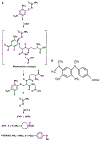Tumor cell responses to a novel glutathione S-transferase-activated nitric oxide-releasing prodrug
- PMID: 15102935
- PMCID: PMC9012296
- DOI: 10.1124/mol.65.5.1070
Tumor cell responses to a novel glutathione S-transferase-activated nitric oxide-releasing prodrug
Abstract
We have used structure-based design techniques to introduce the drug O(2)-[2,4-dinitro-5-(N-methyl-N-4-carboxyphenylamino) phenyl] 1-N,N-dimethylamino)diazen-1-ium-1,2-diolate (PABA/NO), which is efficiently metabolized to potentially cytolytic nitric oxide by the pi isoform of glutathione S-transferase, an enzyme expressed at high levels in many tumors. We have used mouse embryo fibroblasts (MEFs) null for GSTpi (GSTpi(-/-)) to show that the absence of GSTpi results in a decreased sensitivity to PABA/NO. Cytotoxicity of PABA/NO was also examined in a mouse skin fibroblast (NIH3T3) cell line that was stably transfected with GSTpi and/or various combinations of gamma-glutamyl cysteine synthetase and the ATP-binding cassette transporter MRP1. Overexpression of MRP1 conferred the most significant degree of resistance, and in vitro transport studies confirmed that a GSTpi-activated metabolite of PABA/NO was effluxed by MRP1 in a GSH-dependent manner. Additional studies showed that in the absence of MRP1, PABA/NO activated the extracellular-regulated and stress-activated protein kinases ERK, c-Jun NH(2)-terminal kinase (JNK), and p38. Selective inhibition studies showed that the activation of JNK and p38 were critical to the cytotoxic effects of PABA/NO. Finally, PABA/NO produced antitumor effects in a human ovarian cancer model grown in SCID mice.
Figures








References
-
- Armstrong RN (1997) Structure, catalytic mechanism and evolution of the glutathione transferases. Chem Res Toxicol 10:2–18. - PubMed
-
- Boulton TG, Nye SH, Robbins DJ, Ip NY, Radziejewska E, Morgenbesser SD, De-Pinho RA, Panayotatos N, Cobb MH, and Yancopoulos GD (1991) ERKs: a family of protein-serine/threonine kinases that are activated and tyrosine phosphorylated in response to insulin and NGF. Cell 65:663–675. - PubMed
-
- Brünger AT, Adams PD, Clore GM, DeLano WL, Gros P, Grosse-Kunstleve RW, Jiang JS, Kuszewski J, Nilges M, Pannu NS, et al. (1998) Crystallography & NMR System: a new software suite for macromolecular structure determination. Acta Crystallogr 54:905–921. - PubMed
Publication types
MeSH terms
Substances
Grants and funding
LinkOut - more resources
Full Text Sources
Research Materials
Miscellaneous

